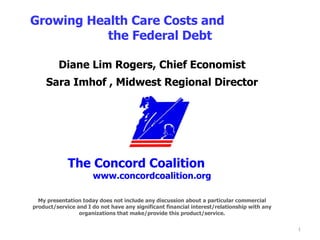
Federal Debt and Rising Healthcare Costs
- 1. Diane Lim Rogers, Chief Economist Sara Imhof , Midwest Regional Director The Concord Coalition www.concordcoalition.org My presentation today does not include any discussion about a particular commercial product/service and I do not have any significant financial interest/relationship with any organizations that make/provide this product/service. Growing Health Care Costs and the Federal Debt
- 2. Current Federal Fiscal Policy $1,800 $1,600 $1,400 $1,200 $1,000 $800 $600 $400 $200 $0 In billions of 1996 constant (chain) dollars 1980 1984 1988 1992 1996 2000 2004 2008 2012 Fiscal Years
- 3. Composition of Projected FY 2009 Federal Government Revenues and Outlays (Deficit: $1.59 Trillion) Estate & Gift Taxes ($21 billion) Other Taxes Corporate Taxes Social Insurance Taxes Individual Income Taxes Outlays: $3.69 trillion Revenue: $2.1 trillion *Includes all appropriated domestic spending such as education, transportation, homeland security, housing assistance, and foreign aid. **CBO classification of funds allocated for TARP, Fannie Mae, and Freddie Mac. Source: CBO August 2009. In Billions of Dollars Financial Rescue** Interest Domestic* Social Security Medicare & Medicaid Other Entitlements Defense
- 4. Social Security, Medicare, & Medicaid as a Percentage of the Federal Budget All other Federal Spending $1.88 Trillion 58% Social Security, Medicare and Medicaid $1.35 Trillion 42% Source: Congressional Budget Office, March 2009. CBO treatment of TARP, Fannie Mae and Freddie Mac: $627 billion
- 5. Where We’ve Been and Where We’re Headed: (Almost Always) Overextended Federal spending vs. revenues as percent of GDP (FY 1980-2019) CBO August 2009 Baseline CBO’s Estimate of the President’s Budget ( June 2009) Source: Congressional Budget Office, August 2009. Average outlays: 21.0% Average revenues: 18.3% Percentage of GDP Actual Projected
- 6. Current Policy Trends Lead to Large Sustained Deficits Fiscal Years 2010-2019 2009 2010 2011 2012 2013 2014 2015 2016 2017 2018 2019 Fiscal Year CBO August 2009 Baseline The Concord Coalition Plausible Baseline assumes that discretionary spending grows at the rate of nominal GDP, that war costs slow gradually, and that all expiring tax provisions (including those from 2009 stimulus package) are extended with AMT relief. Source: Congressional Budget Office, August 2009 and Concord Coalition analysis. Billions of Dollars -$14.4 Trillion Deficit -$7.1 Trillion Deficit
- 7. Current fiscal policy is on an unsustainable path Federal Outlays as a Percentage of GDP Social Security Medicaid Medicare All Other Interest Source: Government Accountability Office, September 2008. Average tax revenue
- 10. America’s Population is Aging Population age 65 and Over Source: Social Security and Medicare Trustees’ Report, April 2008. Year Percentage of Population Aged 65 and Over
- 11. Health Expenditures as a Percent of GDP (1960-2018) *Projected Source: Centers for Medicare and Medicaid Services.
- 12. Total and Per Capita Spending on Health Care, 1965 to 2005 Source: Congressional Budget Office based on data on spending on health services and supplies, as defined in the national health expenditure accounts, maintained by the Centers for Medicare and Medicaid Services. Note: Spending amounts are adjusted for inflation using the gross domestic product implicit price deflator from the Bureau of Economic Analysis. (Per capita in thousands of 2005 dollars) (Total in trillions of 2005 dollars)
- 13. Health Care Costs are Rising Faster Than the Economy Source: Congressional Budget Office, December 2007. Percentage of GDP All Federal Revenues In Fiscal Year 2007 All Federal Spending In Fiscal Year 2007 Assumes that health care cost growth will not exceed GDP growth. Assumes that health care cost growth continues at the average rate for the past 40 years (2.5 percentage points greater than GDP growth.) Assumes that health care cost growth rate declines to 1.0 percentage point greater than GDP growth—consistent with the assumption used by the Medicare Trustees.
- 14. The Relationship Between Quality and Medicare Spending, by State, 2004 Composite Measure of Quality of Care Source: CBO Data from AHRQ and CMS.
- 15. Variations Among Academic Medical Centers Use of Biologically Targeted Interventions and Care-Delivery Methods Among Three of U.S. News and World Report ’s “Honor Roll” AMCs Source: CBO and Elliot Fisher, Dartmouth Medical School. UCLA Medical Center Massachusetts General Hospital Mayo Clinic (St. Mary’s Hospital) Biologically Targeted Interventions: Acute Inpatient Care CMS composite quality score 81.5 85.9 90.4 Care Delivery―and Spending―Among Medicare Patients in Last Six Months of Life Total Medicare spending 50,522 40,181 26,330 Hospital days 19.2 17.7 12.9 Physician visits 52.1 42.2 23.9 Ratio, medical specialist / primary care 2.9 1.0 1.1
- 16. Medicare’s Fiscal Future Relates to ALL of us
Notas del editor
- Add closing